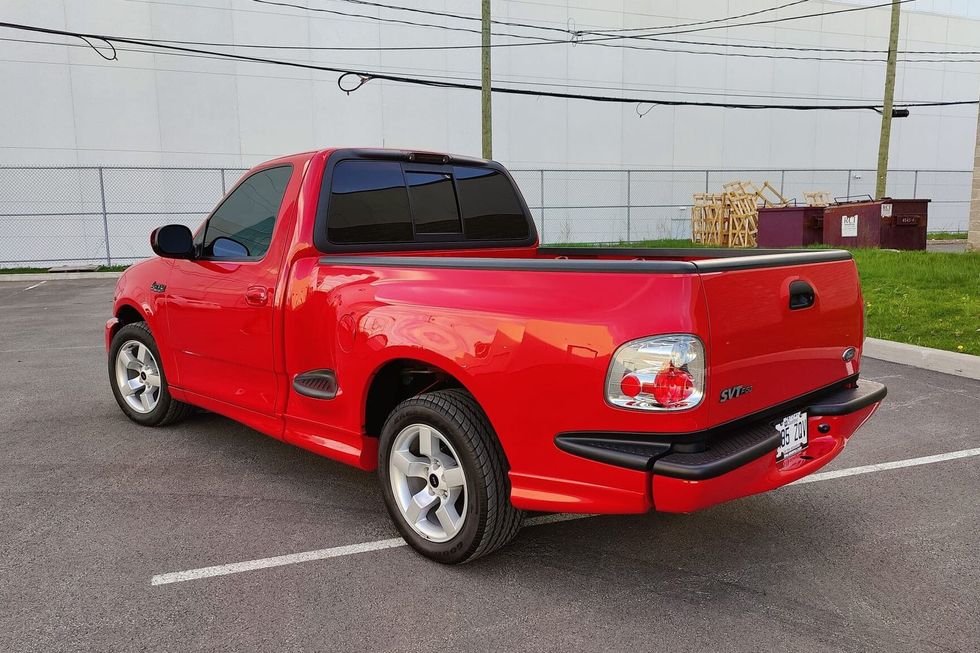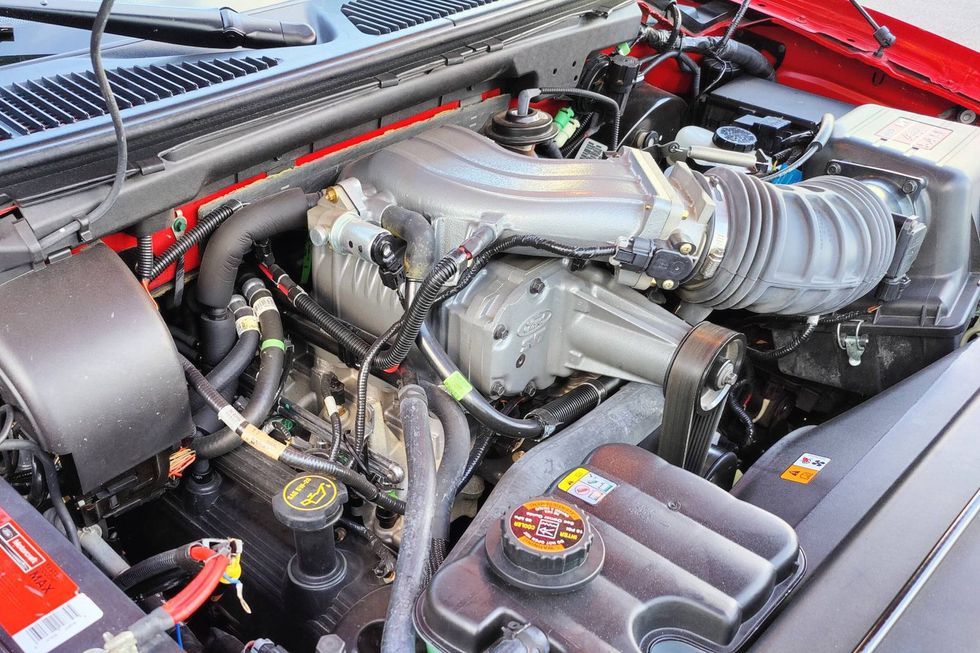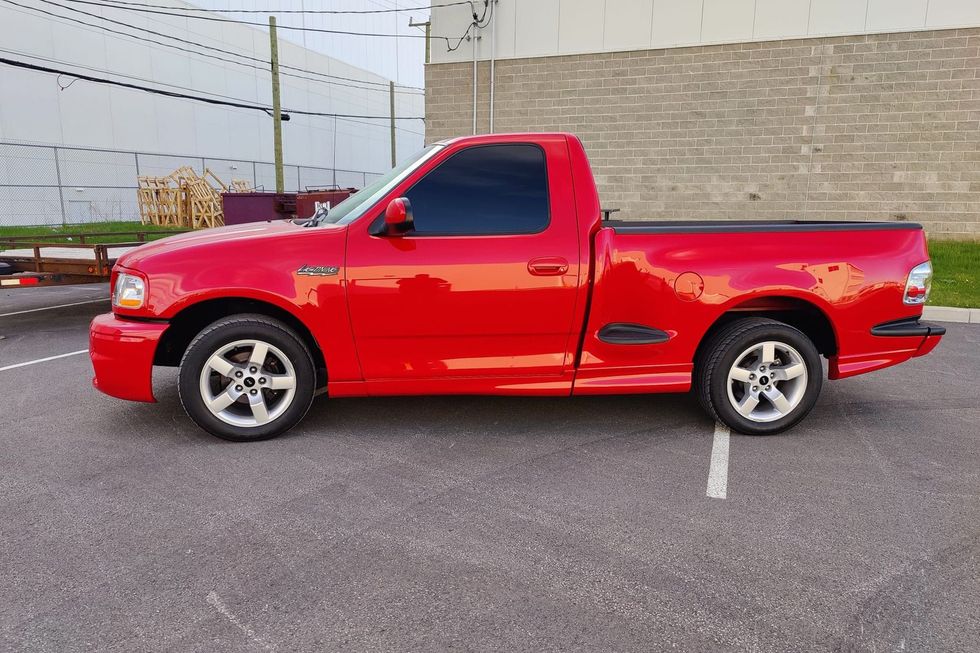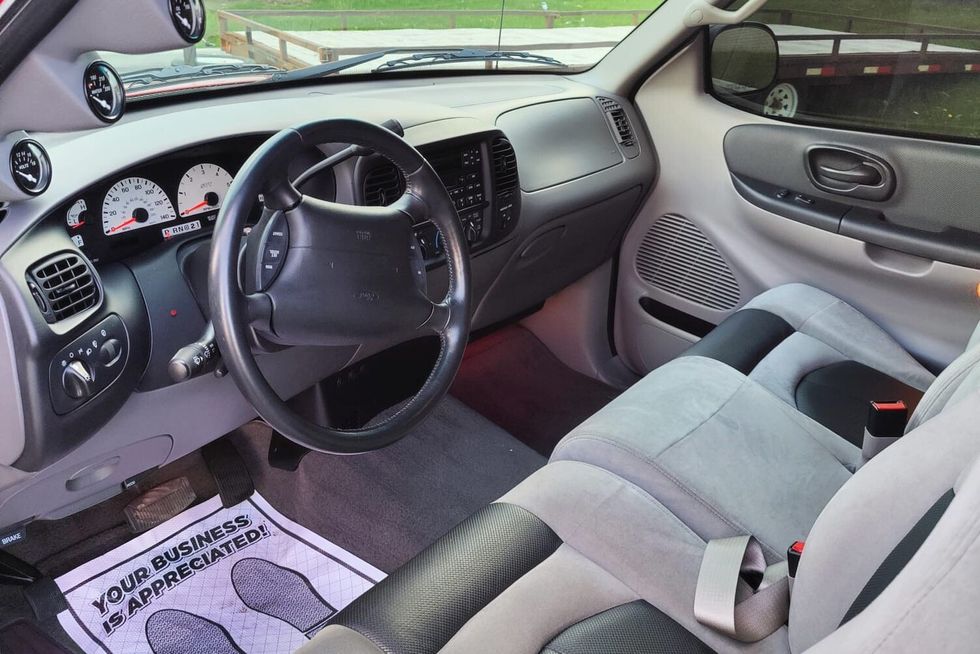Strikingly Stylish - 1960 Ford Thunderbird
If ever there was a car that represented all that was great about mid-century Detroit styling, the 1960 Thunderbird is it
09/23/2018


The country was aghast when the new-for'58 Thunderbird was stretched into a four-seater. Everyone, it seemed, loved the cute, cozy styling of the small T-Birds that preceded it. For the era, they were sensational-looking cars--they still are today--but not everyone who lusted after a 1955-'57 Thunderbird could justify buying one due to their limited seating capacity. And so, many didn't.
Adding those two extra seats in the back changed everything. Sales skyrocketed, and the all-new, bigger, roomier and more practical Thunderbird became the must-see car in Ford showrooms that year. It was the talk of the town, and Americans everywhere wanted to be seen driving one.

For the most part, the Square 'Bird's design remained consistent across all three years it was produced. Those changes that were made year to year were minor, centering on different trim and other tacked-on embellishment. The most obvious external differences were the grille, which was redesigned each year, the taillamps, and the trim that adorned the side of the body.
Our feature Thunderbird, owned by Dennis Roxworthy of Elgin, Illinois, was built in August of 1960, a full year after the first 1960 models started rolling off the line at Ford's Wixom assembly plant. As a result, it's certainly one of the better cars built, as all of the production bugs had been worked out by then, and the line workers were already very experienced in putting them together. Production of the Square 'Birds stopped a month later, bringing an end to one of the most successful cars Ford ever produced.
In fact, so successful was the 1960-model Thunderbird that 92,465 examples were built. The data plate on our feature car states that it is number 91954, one of the last Square 'Birds produced. The VIN plate also shows a code E, indicating the rarely seen Acapulco Blue Metallic, a color that was also available on Lincoln Continentals. Ford offered 23 different single colors for the Thunderbird this year, as well as 44 different Tutone color combinations, but Acapulco Blue is perhaps the most spectacular of them all. And when combined with the light beige leather upholstery, as on this car, it makes for a truly outstanding, sophisticated color scheme. The official code is Trim #84, one of four colors available in leather; there were also six vinyl color options and six for the combination of vinyl bolsters and nylon cord fabric.
As for the powertrain, only two engines were offered for the 1960 Thunderbird: the 300hp, 352-cu.in. V-8, and the 350hp, 430-cu.in. V-8. Don't be misled by all the different Thunderbird-named engines that Ford offered during this period because, as odd as it may seem, most of them were not available in Thunderbirds.
The fifth character in this car's serial number is a "Y," which is the engine code that denotes the 352-cu.in. Thunderbird Interceptor V-8. It's fitted with the Ford four-barrel carburetor that was assigned when the Cruise-O-Matic transmission was ordered, as this car was originally optioned. That Cruise-O-Matic is a smooth-shifting transmission, with robust internals that have earned it a solid reputation for reliability and durability.
In the rear, the axle code on the data plate is a "3," which means that this car is equipped with the 3.10:1 rear axle ratio. That fairly tall gearing makes it very highway-friendly at speed, reducing engine speed for more relaxed cruising. Had that code been a "C," then the differential would have been fitted with the very desirable Equa Lok posi unit.
It's readily apparent that this is a spectacularly handsome Thunderbird, particularly sporting its Acapulco Blue finish, which is what initially drew owner Dennis in; of course, all the options it has been fitted with were attractive, too. But what Dennis likes most is just how easy it is to get into the car. He told us, "I have 25 collector cars, and the one feature of this Thunderbird that I like most is that it has four-foot-wide doors. It is really easy to enter, and the seats fold flat to get in and out, with an interior that is very roomy. And the huge luggage compartment has 20.5-cu.ft. of space, allowing for at least four suitcases.
"This Thunderbird drives very smoothly. All the controls are in view when driving and the bucket seats are very comfy. And when you're in that seat, you have excellent visibility all around, plus that view of the hood scoop is just great," Dennis said. "With that 352-cu.in. engine under the hood, there's plenty of power, and that Cruise-O-Matic transmission shifts very smoothly. More importantly, not only does it have excellent passing power, but it also has plenty of low-end muscle from a standing start all the way to 100 MPH.
"At highway speed, between 40 and 50 MPH, it glides down the road very well. She lays flat and hugs the road very well; over 80 MPH, she will tend to float," Dennis said. "And even on the bias-type tires, the car doesn't wander, even on bad roads. I also have a red 1960 T-Bird convertible with the optional 430-cu.in. V-8, and it's very front-end heavy, but not this car; this one is very easy to drive."
When he's cruising along winding roads, Dennis went on to say that, "the car handles well and steers smoothly, but if you turn the wheel too fast at a relatively decent speed, she will tend to rock and roll a bit. The power steering is real easy and has a good turning radius, and the brakes work very well. You can tell this Thunderbird is heavy, because it floats down the road like a driver's car of the day."
In order to maintain his Thunderbird so it always delivers peak performance, and to ensure that it stays in fine shape, Dennis carries out a full service on the car every spring. This includes a change of oil, replacing all the filters, a spark plug cleaning, and a tune-up. He relies on the superior protection ability of 10W30 Mobil 1 synthetic oil to help reduce internal engine wear.
My own time behind the wheel of this fabulous-looking Ford lasted only about 20 minutes, but the memories will last a lifetime--or at least until I buy a 1960 Thunderbird of my own. Getting my 6'-4" frame into the car was relatively easy, although I had to make sure the wraparound windshield's elbow didn't crack my kneecaps. The seats were very comfortable and fairly supportive, with the steering wheel and console falling in place exactly where they should; a long-distance drive would not be an issue in this car. And I reveled in the T-Bird's low-down seating position, since I like the sense of sitting in a car and feeling like I'm an intrinsic part of the interior, not like I'm perched on a ledge atop its chassis.
Most stunning of all the interior features is this T-Bird's dashboard. The round, black on white gauges with their bright orange pointers and gold centers makes you feel like a million bucks while driving, and the way the light bounces off the pleated metal dash panel was not distracting, as I first thought it would be. Very impressive indeed.
The way the interior is divided into two separate pods, with a finely crafted vinyl-covered console separating the occupants, it affords you a very cozy feeling that is highly enjoyable to experience. The interior is wide enough that my shoulders didn't rub up against the door, and there was plenty of space between my head and the headliner. Seeing the bulbous hood scoop popping up from that large expanse of blue sheetmetal before me was a treat, and with the oval "gunsights" atop each fender giving me the proper sight line while turning, the driving experience was one of relative ease, with a reassuring feel that was quite relaxing.
In the performance department, the acceleration was plenty to get you daily speeding tickets, with lots of low-end torque to get the 3,800-pound machine up to speed quickly and without drama. The transmission shifted at the right speed, with the gear changes barely noticeable. The drum brakes performed well, without any pulling or fade, but then again, I didn't use them overly much, nor did I drive the car aggressively. After all, these are boulevard cars designed for relaxed cruising; they weren't meant to be driven like a sports car, which would be hard to do anyway. My biggest complaint was with the wide-ratio steering--but all Fifties and Sixties cars have that same slow steering reaction. It's simply that I personally prefer steering that has a quicker ratio, of at least 12:1, which provides a more reassuring control of the car's directional abilities.
On one leg of our journey through the charming riverside town of Elgin, Illinois, while coming down a fairly steep grade at speed and immediately crossing the rails of the Illinois Railroad's commuter line, the T-Bird's unitized structure didn't even flinch or flex. It exhibited nothing but solid performance, without any drama, creaks or rattles. The car just glided across the tracks, its compliant suspension soaking up the irregularities of the road surface with no noticeable transmission of excessive noise or jounce.
Driving this Thunderbird was a whole lot of fun, with everyone waving and giving us the thumbs-up as we passed, but my favorite thing about the car isn't so much how it drives but rather, the way it looks. So interesting is the Square 'Bird's body design that I can stare at it for hours on end without getting bored of its shape. Few automotive shapes can hold my attention for more than a few minutes, but these model Thunderbirds seem to captivate me and hold my attention hostage like few other cars can.
With its massive bumper incorporating the expansive grille opening, the recessed grille's square mesh metal design is accented by a trio of vertical wedge-shaped bars, providing the front end with a look of robust sophistication; this same mesh pattern can be seen in the rear, surrounding the taillamps. The bumper's delicately shaped center crown leads the eye up onto the expansive hood and into the muscular-looking hood scoop.
The most defining part of the Square 'Bird's shape is the way the front fender's integrated angled eyebrow wraps around the dual headlamps and makes a decisive line down the body side, separating the body's upper and lower areas. When it reaches the door, its graceful downward curve leads your eye into a sculptured spear that anchors the car's rear end, projecting a sense of wind-splitting precision.
A few inches before the door handle, the tailfin begins, rising up some six inches in height at its rearmost location, canted outward like wings on a jet. The fin's line wraps around the rear taillamp pod, then flows into the bumper. The continuity of the line isn't broken, as the bumper completes the framing of the three round taillamps as it curves back under, then it wraps around and becomes the end point for the aforementioned side spear. Simply outstanding.
If ever a car could be considered a masterpiece of exhilarating automotive styling--the kind of design that stimulates the senses with endless elements and interesting shapes that feed off one another--the 1958-'60 Thunderbird is it.
Owner's View
One of the reasons Dennis is so smitten with his Square 'Bird is because both his dad and older brother bought new 1960 Thunderbird hardtops: "Dad's car was Corinthian white with a black and white interior, and my brother's car was Corinthian white with red and white interior. I just loved these cars. When I was in high school, driving Dad's Thunderbird, I just felt special to be driving the first personal luxury car to come out of Detroit.
"I bought this Acapulco Blue example with tan leather interior because it just grabbed me at first sight; I love the way it looks. It was repainted the factory color by the first owner, because he said the original paint was starting to fail. Other than the repaint, this is a very original, no-hit, no-rust T-Bird that's been babied its whole life. The car was never driven in winter at all.
"To me it's one of the most beautiful cars of the Fifties and Sixties."
-- Dennis Roxworthy
SPECIFICATIONS
Base price: $3,755
Price as optioned: $4,741.40
Options on car profiled: Cruise-O-Matic transmission, $242; Masterguide power steering, $75.30; Swift Sure power brakes, $43.20; Power seat, $92.10; Power windows, $102.10; Center console radio, $112.80; Magicaire heater, $82.90; Back-up lamps, $9.50; Aquamatic windshield washer, $13.70; I-Rest tinted glass, $37.90; Genuine leather upholstery, $106.20; 8.00 x 14 whitewall tires, $35.70; Safety seat belts, $22.80; Outside rearview mirror: left, $5.10; Outside rearview mirror: right, $5.10.
ENGINE
Type -- OHV V-8, cast-iron block and cylinder heads
Displacement -- 352 cubic inches
Bore x Stroke -- 4.00 x 3.30 inches
Compression ratio -- 9.6:1
Horsepower @ RPM -- 300 @ 4,600
Torque @ RPM -- 381-lbs.ft. @ 2,800
Valvetrain -- Hydraulic valve lifters
Main bearings -- Five
Fuel system -- Four-barrel Ford carburetor
Lubrication system -- Pressure, gear-type pump
Electrical system -- 12-volt
Exhaust system -- Dual exhaust
TRANSMISSION
Type -- Cruise-O-Matic three-speed automatic
Ratios:
1st -- 2.40:1
2nd -- 1.47:1
3rd -- 1.00:1
Reverse -- 2.00:1
DIFFERENTIAL
Type -- Hypoid, semi-floating axles
Final drive ratio -- 3.10:1
STEERING
Type -- Recirculating ball, power assist
Turns, lock-to-lock -- 4.1
Ratio -- 25:1
Turning circle -- 40.375 feet
BRAKES
Type -- Four-wheel hydraulic drums, power assist
Front -- 2.5 x 11-inch drums
Rear -- 2.75 x 11-inch drums
CHASSIS & BODY
Construction -- Fully unitized body/frame
Body style -- Two-door hardtop coupe
Layout -- Front engine, rear-wheel drive
SUSPENSION
Front: Independent, unequal-length A-arms, ball joints, coil springs, hydraulic tubular shocks and link-type anti-roll bar
Rear: Solid rear axle, semi-elliptic leaf springs and hydraulic tubular shocks
WHEELS & TIRES
Wheels -- Steel, five-lug, with full wheel cover
Front -- 14 x 5 inches
Rear -- 14 x 5 inches
Tires -- White sidewalls 4-ply nylon
Front -- 8.00 x 14
Rear -- 8.00 x 14
WEIGHTS & MEASURES
Wheelbase -- 113 inches
Overall length -- 205.4 inches
Overall width -- 77 inches
Overall height -- 52.5 inches
Front track -- 60 inches
Rear track -- 60 inches
Shipping weight -- 3,799 pounds
CAPACITIES
Crankcase -- 5 quarts
Cooling system -- 20 quarts
Fuel tank -- 20 gallons
Transmission -- 10 quarts
CALCULATED DATA
HP per cu.in. -- 0.852
Weight per hp -- 12.66 pounds
Weight per cu.in. -- 10.79 pounds
PRODUCTION
1960 Hardtop -- 80,938
Convertible -- 11,860
Total -- 92,798
PROS & CONS
+ Fantastic styling outside and in
+ Plenty of power and comfort
+ Growing selection of reproduction parts
- The Rodney Dangerfield of T-Birds
- Poor gas mileage for tree huggers
- A smidgen more agility would be nice
WHAT TO PAY
Low -- $6,000 - $9,000
Average -- $11,000 - $14,000
High -- $16,000 - $20,000
CLUB CORNER
Vintage Thunderbird Club International
P.O. Box 58872
Tukwila, Washington 98138-2872
www.vintagethunderbirdclub.org
Dues: $35/year
Membership: 1,500
International Thunderbird Club
20 Northview Drive
Hanover, Pennsylvania 17331-4521
www.intl-tbirdclub.com
Dues: $26/year
Membership: 665
Forget Ford’s groundbreaking electric truck for a moment to consider this 2001 Ford SVT F-150 Lightning now offered on Hemmings Auctions. Instead of the dual permanent-magnet motors found in the current electric Lightning, the 1999-2004 SVT Lightning featured a supercharged version of Ford’s 5.4-liter “modular” OHC V8. Rated at 380 horsepower in the 2001-’04 models, it was good enough to make a stock lightning a formidable opponent on the street as well as at the strip.
A follow-up to the original 1993-’95 F-150 Lightning, which was a high-performance version of a standard F-150, the second-generation SVT super truck presented as a more thoroughly developed model with a lot more exclusive components that further differentiated it from the rest of the F-Series lineup. Beyond the engine, the entire suspension and braking system, not to mention aerodynamic body add-ons, were part of the Lightning package from 1999 through 2004. Exclusive interior components were also part of the package.
At the heart of this SVT Lightning is its iron-block 5.4-liter SOHC, 16-valve V8 with a supercharger and an intercooler. The blower helped it deliver 380 horsepower and 450 lb-ft of torque in 2001, up some 20 horsepower and 10 lb-ft from the ’99 and 2000 models. The Eaton supercharged engine delivered peak boost of 8.0 psi and the engine featured an 8.4:1 static compression ratio, down from the standard 5.4 V8’s 9.0:1, which was rated at 260 horsepower and 350 lb-ft.
Power reached the rear 18-inch cast aluminum-alloy wheels via a four-speed automatic, an aluminum driveshaft and a beefy 9.75-inch, limited-slip rear axle with an acceleration-friendly 3.73:1 final-drive ratio, another upgrade for 2001. Car and Driver magazine reported a 0-60 mph time of 5.2 seconds and a quarter-mile in an E.T. of 13.8 seconds at 104 mph—impressive numbers for a 4,600-pound truck. Top speed was a drag-limited 142 mph.

Trucks generally require a suspension that can handle a full load in its bed while also providing competent driving while empty. But if you fancy one designed to a sports-car standard, then something has to give. In the case of the second-gen Lightning, Ford dropped its payload capacity to a mere 800 pounds. A standard 2001 F-150 Styleside carried a 3,180-pound payload rating, while an F-150 Flareside was rated at 2,005 pounds, some two-and-a-half times the Lightning, which featured the short-bed Flareside body. Towing capacity, likewise, was reduced from 8,800 pounds to 5,000 in the Lightning. But the Lightning’s strengths were never its payload or towing capacities, but it’s ability to perform like a sports car.
As a 21st century performance vehicle, however, the second-gen Lightning was also equipped to handle. A half-inch drop at the front was accompanied by SVT-specific coil springs and Bilstein shocks along with an exclusive 31-mm solid anti-roll bar. SVT’s influence continued at the rear with Lightning-specific five-leaf springs and a 23-mm solid anti-roll bar. The Bilstein setup at the rear included the right-rear shock staggered toward the front of the truck to reduce axle hop under heavy acceleration. The four-wheel antilock disc brakes were cribbed from the three-quarter-ton F-250, with 12.1-inch front rotors at the front and 13.1-inch discs at the rear.

As the years go on, fewer and fewer clean, unmolested low-mileage examples are out there, which is why this 2001 Ford SVT F150 Lightning now on Hemmings Auctions caught our attention. Showing just 5,525.5 miles on its odometer at the time of submission, it is said to be in “mint” condition and have an “immaculate” finish in the seller’s words. No modifications are noted to any part of the vehicle. The 18-inch factory alloys don’t appear to have any curb rash, though the Goodyear performance tires may be original. About the only deviations from stock are the tinted windows.
The latest electric-only F-150 Lightning is certainly a quick vehicle in its own right, but this 2001 edition from the engineers at SVT was built for excitement, not range. It was made with an old-school muscle-car vibe along with modern handling and braking. Which Lightning would you look good behind the wheel of?
Take a look at this second-gen Lightning on Hemmings Auctions before the bidding ends.

Spring is here. As the snow melts and the daffodils bloom, it’s time for many vintage cars to emerge from winter hibernation and get back on the road. Thinking of adding to the collection? We have 10 vehicles in spring-like shades of yellow – including cars and trucks, U.S. and European – to catch your eye.

















































